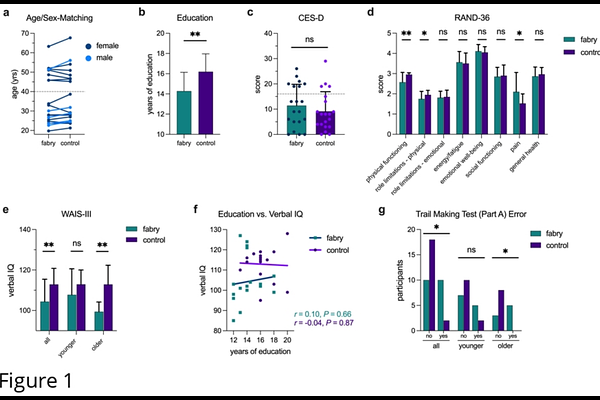The insidious degeneration of white matter and cognitive decline in Fabry disease

The insidious degeneration of white matter and cognitive decline in Fabry disease
Johnson, J. W.; Baradaran, H.; Morgan, J.; Odeen, H.; Friel, E.; Bailey, C.; Zielinski, B. A.; Underhill, H. R.
AbstractFabry disease is a rare X-linked deficiency of lysosomal alpha-galactosidase that causes glycolipid accumulation in tissues, including the brain. The most common neurologic sequelae of Fabry are cognitive decline and white matter lesions (WMLs) on brain magnetic resonance imaging (MRI). In the at-large population, however, WMLs are non-specific, highly prevalent, and most are clinically silent. Thus, we compared Fabry to typical brain aging to identify factors unique to Fabry-related cognitive decline. Twenty adult Fabry patients (75% female; median age 36.4 yrs, range: 19.8-63.2 yrs; 95% on enzyme replacement therapy) without a history of stroke or other neurologic diseases and 20 age/sex-matched healthy controls were enrolled in a case-control study. All participants underwent a neurocognitive assessment and a 3.0 T MRI study of the brain that used structural MRI (e.g., fluid-attenuated inversion recovery, FLAIR), semi-quantitative MRI (e.g., normalized FLAIR signal intensity), and quantitative MRI (diffusion tensor imaging, bound-pool fraction imaging). During a blinded review of structural MRIs, a neuroradiologists categorization of case-control status did not correspond to disease status (Fishers test, P>0.99) but rather to age (P=0.004), indicating qualitative changes associated with Fabry were similar to normal age-related brain alterations. Using quantitative MRI, however, we detected evidence of microstructural damage in the white matter of younger Fabry adults (<40 yrs). With age, WML severity increased and the corpus callosum atrophied in Fabry, phenomena absent in controls and consistent with progressive tissue damage. Neurocognitive assessments identified trends for lower verbal intelligence quotient and executive function in the younger Fabry participants, which became statistically significant in the older Fabry cohort. Our data indicate that the early onset of microstructural damage in Fabry drives the insidious degeneration of white matter, leading to reduced cognition. Aging Fabry patients may benefit from serial cognitive assessments to identify unmet therapeutic needs.